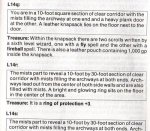I'd like to throw two things into this discussion:
1) AD&D included rules to create dungeons randomly. The tables include empty rooms, rooms with monsters, rooms with treasure, and rooms with both.
Back in the days almost everyone I knew created their own adventures rather than using 'official' modules. I believe a lot of those adventures have been created using those guidelines as a starting point and thus definitely included treasure lying around unhidden and unguarded, though of course treasure more often actually was guarded and/or hidden.
2) To be honest I totally do not care if treasure was lying around or not. What irked me a lot more were (and are) adventure modules that include (magic) items that are especially easy to get because the module designer felt they were required to 'beat' the module.
E.g. an adventure that included a room with a basilisk would typically include a scroll of protection from petrification somewhere close to the start of the dungeon (or at least well before the basilisk room).
Similarly, adventures would (and will) include ways to breathe water, ignore poison gas, become ethereal, fly, etc. because an encounter requires it.
I know that some people feel that this is good design because every adventuring party might be different and may or may not have the equipment to deal with the adventure, but that's something I disagree about.
I vastly prefer the approach to plant hints about the challenges and providing the party with an opportunity to do prepare for them if they a) got the hints and b) care to prepare.
1) AD&D included rules to create dungeons randomly. The tables include empty rooms, rooms with monsters, rooms with treasure, and rooms with both.
Back in the days almost everyone I knew created their own adventures rather than using 'official' modules. I believe a lot of those adventures have been created using those guidelines as a starting point and thus definitely included treasure lying around unhidden and unguarded, though of course treasure more often actually was guarded and/or hidden.
2) To be honest I totally do not care if treasure was lying around or not. What irked me a lot more were (and are) adventure modules that include (magic) items that are especially easy to get because the module designer felt they were required to 'beat' the module.
E.g. an adventure that included a room with a basilisk would typically include a scroll of protection from petrification somewhere close to the start of the dungeon (or at least well before the basilisk room).
Similarly, adventures would (and will) include ways to breathe water, ignore poison gas, become ethereal, fly, etc. because an encounter requires it.
I know that some people feel that this is good design because every adventuring party might be different and may or may not have the equipment to deal with the adventure, but that's something I disagree about.
I vastly prefer the approach to plant hints about the challenges and providing the party with an opportunity to do prepare for them if they a) got the hints and b) care to prepare.

